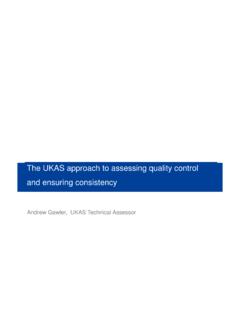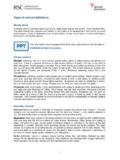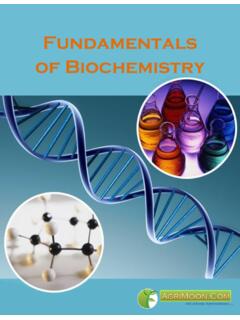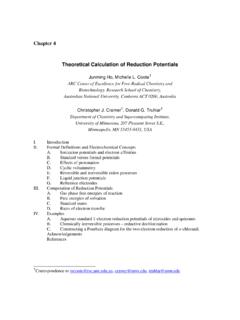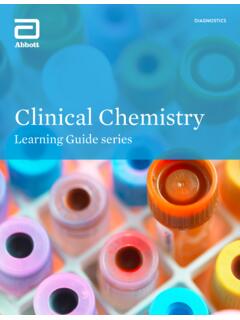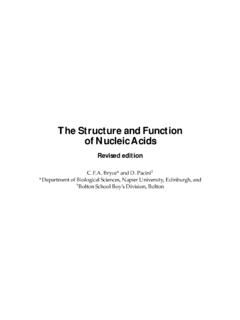Transcription of Separation, purification and identification of the ...
1 Supplementary information for Comprehensive organic chemistry Experiments for the Laboratory Classroom The Royal Society of chemistry 2017 Separation, purification and identification of the components of a mixture Supplementary Material Experimental notes Background Experimental Figures Photos of the IR Experimental notes Background topics This experiment does not involve typical chemical reactions of organic compounds, with the exception of acid-base reactions. Its aim is to provide the students the knowledge of fundamental experimental techniques of unitary operations, such as extraction, distillation, filtration, recrystallization and thin layer chromatography.
2 The work (two laboratory sessions) has a low difficulty level and is adequate to introductory level students, especially engineering students (chemical, biochemical, material sciences, biomedical and related areas) or chemistry students at introductory level. This simple pedagogic experiment was already realized by over 500 students of the Faculty of Sciences and Technology, Universidade Nova de Lisboa (in classes of 22 students/class, 11 groups of two), who accomplished the work in two (2x3 hours) laboratory sessions.
3 The students must be encouraged to rationalise the principles of the unitary operations performed and to understand their application. If this work is a first experiment in an organic chemistry laboratory class, every experimental detail must be extensively discussed. Special attention and care must also be given to collection and treatment of results (calculation of Rf values and recuperation yields , measurement of physical properties, melting points). It is also important to encourage the students to compare the experimental results with those referred in the literature.
4 Hints for the answers to the proposed questions and topics to discussion: 1. Deprotonation of the carboxylic group of benzoic acid and protonation of the amino group of p-toluidine. 2. Chemically inert; not mixable with the solution to extract; possible low boiling point; .. 3. Removal of traces of acid / base. 4. Assure complete precipitation. 5. Removal of traces of water. Supplementary information for Comprehensive organic chemistry Experiments for the Laboratory Classroom The Royal Society of chemistry 2017 Experimental details Experimentally the work is simple, with low difficulty and hazard levels.
5 In the separation step explain to the students how to recognize and distinguish an organic layer from an aqueous layer and how to separate them correctly. Ask them how to increase the rate of an extraction. In the recovery step it is important to assure the complete reversal of the pH of the solutions for complete precipitation of the compound to be isolated. Ask the students how to test if this has occurred and how to proceed if the result is not satisfactory (use indicator paper and add more acid or base if necessary).
6 Concerning the naphthalene solution in methylene chloride left after extraction with aqueous solutions, teach the students how to dry a liquid (use of a good drying agent, clearness of the liquid, efficient filtration). The TLC part is very important to verify the success of the experiment. Show the students how to apply the samples, to prepare the camera, to develop the elution, to reveal the spots. Encourage them to compare the spots from the initial mixture with the spot(s) from each separated compound. Show them how to calculate correctly the Rf values.
7 Average Rf values (CH2Cl2 / silica gel plates): benzoic acid = ; p-toluidine = ; naphthalene = The results of the TLC test show clearly which of the three isolated compound is less pure. Usually it is naphthalene; ask the students the reason (it is the last one remaining after the sequential separation steps and accumulates all the impurities). Naphthalene is therefore the better candidate to be purified by recrystallization. However, it should be interesting to suggest other groups in the laboratory classroom to recrystallize also p-toluidine and benzoic acid, and encourage all the students to share the results obtained by each group.
8 Recommended solvents for recrystallization are: commercial ethanol for naphthalene; distilled water for benzoic acid; petroleum ether (40-60 ) for p-toluidine. For every compound the students must weigh the amount of the compound before (crude) and after (purified) recrystallization. The same applies to the measurement of the melting points. In both cases, the results should be compared and interpreted. Discuss with the students the melting point value as a criterion of purity of a compound (comparison with values from the literature).
9 Some experimental results obtained by the students in the laboratory are presented in Table Table SM Typical experimental results obtained in the Laboratory Compound Recuperation (%) Melting point ( C) p-toluidine 40 - 48 40 - 43 benzoic acid 40 - 67 110 - 115 naphthalene (crude) 72 - 80 74 - 77 naphthalene (recrystallized) 40 - 50 78 - 79 Supplementary information for Comprehensive organic chemistry Experiments for the Laboratory Classroom The Royal Society of chemistry 2017 Finally, an additional characterization can be made by recording the IR spectra of the purified compounds.
10 For this purpose a further 3 hours session may be needed. Students will be familiarized with the technique of preparing a solid transparent disc for IR spectroscopy, by using a small amount of a dried sample of the purified compound and KBr as the adequate support material. The assignment of the absorption bands characteristic of the functional groups of the compounds will be an excellent complement of the work. Figures Photos of the experiment Fig. SM Acid/base extraction Fig. SM Recovery of naphthalene Supplementary information for Comprehensive organic chemistry Experiments for the Laboratory Classroom The Royal Society of chemistry 2017 Fig.





